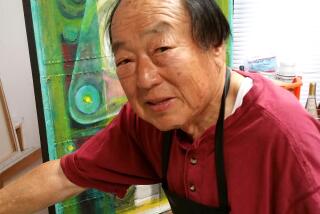Empress Dowager Nagako; Widow of Japan’s Hirohito
- Share via
TOKYO — Empress Dowager Nagako, who reigned with the late Emperor Hirohito during Japan’s World War II aggressions and its rise from the ashes into an economic power, died Friday at the Imperial Palace. The widow of the country’s longest-serving monarch was 97.
The elegant, grandmotherly Nagako, known for her gracious smile, died after suffering respiratory problems and slipping into a coma. Her death dominated evening news programs in Japan, with footage showing the empress dowager during her reign with the emperor and in recent years when she was in a wheelchair.
In commemoration of her death, many neon signs in Tokyo’s flashy Ginza section were turned off, as were the lights in Tokyo Tower, a replica of France’s Eiffel Tower.
“Her smile especially attracted many people and eased Japanese hearts and feelings during the dark wartime,” said Yasushi Kuno, commentator on Nippon Television’s periodic “Imperial Family Diary” program. “Her character was very modest and softened Hirohito.”
The last Japanese empress from royal stock, Nagako was chosen for her imperial role at the age of 14 when her future mother-in-law is said to have spotted one particularly elegant girl at the elite Gakushuin Girls Middle School in Tokyo. Nagako was the daughter of Prince Kuniyoshi Kuni.
But there were other prospective brides for Hirohito, and some rival royal families tried to stop the engagement with allegations that Nagako was colorblind, which was never proved.
Nagako and her future husband were said to have met only nine times during their six-year engagement, and never once were they left unchaperoned. The great Kanto earthquake, which destroyed much of the capital in September 1923, forced them to postpone their wedding until the next year. When they were married in a Shinto ceremony Jan. 26, 1924, Nagako was 20, and then-Crown Prince Hirohito was 22.
On Christmas in 1926, Nagako became empress when Hirohito ascended the Chrysanthemum Throne after the death of his father, Emperor Taisho.
Like Hirohito, Nagako was tutored by two American Quakers, Elizabeth Vining and Esther Rhoads, who are said to have helped instill the democratic ideas that eventually took hold in the imperial family. Before 1946, when Japan’s constitution was revised under U.S. pressure, the emperor was considered to be divine.
Nagako’s views are said to have influenced her husband to end the policy of using concubines to produce male heirs in the imperial family--which wasn’t easy, because the first four children she bore were girls.
Members of the strict Imperial Household Agency nicknamed the empress onna bara--literally, “girl womb” or “girl tummy”--and insisted that the emperor have a concubine to produce a male heir to ascend the throne.
“The emperor said it was against human ethics and refused,” commentator Kuno said.
The next child was a boy, Akihito, the current emperor, followed by two more children, a boy and a girl. Three of her seven children have died: the second child in infancy, Princess Teru at the age of 35 in 1961, and another daughter, Kazuko, at the age of 59 in 1989.
The empress made it her business to attend to all the emperor’s needs, even choosing ties for him in later years. She called him okami, or “honorable master,” and he affectionately nicknamed her Naga-Miya, or Princess Naga.
When the imperial couple stayed at the palace during the wartime bombing of Tokyo and their children were sent away to the countryside, she and the emperor grew vegetables in a plot at the palace because food was in short supply.
After the war, she said that “her heart was in pain when she saw the emperor deeply agitated every day during and immediately after World War II,” according to NHK television. Afterward, she traveled throughout Japan visiting orphans and the bereaved. “She said she could share the sorrow and pain of the people who lost loved ones during the war, wondering how she could ease their pain,” NHK said.
She spent her time writing 31-syllable Japanese poetry known as waka, publishing a collection in 1974, and doing traditional Japanese paintings of landscapes and still lifes, signing her artwork Toen, or Peach Garden.
Two collections of her paintings were published, and she presented one of her pieces to Britain’s Queen Elizabeth II on a European tour in 1971. Four years later she visited the United States, where her itinerary included a trip to Disneyland and a handshake with Mickey Mouse. A Belgian newspaper described her smile as “angel-like.”
In the last two decades, back and hip problems hobbled the empress. She stopped appearing at public ceremonies after Hirohito’s 86th birthday celebration in 1987 and was not able to attend his funeral in 1989.
She spent her last years at the Fukiage Omiya Palace on the Imperial Palace grounds, where she is said to have been tended by about 40 court ladies and medical experts.
Her funeral is expected to be held in late July after a summit of industrialized nations in Okinawa. She will be buried in Musashino Grave in Tokyo, where Hirohito is interred.
The current emperor and empress and other royal family members will be in official mourning for 150 days, divided into three periods. In the strictest period, weddings and birthday celebrations, tea parties and other celebrations for royal family members will be canceled and the royal family members will not attend events such as dinners.
*
Hisako Ueno of The Times’ Tokyo Bureau contributed to this story.
More to Read
Sign up for Essential California
The most important California stories and recommendations in your inbox every morning.
You may occasionally receive promotional content from the Los Angeles Times.













